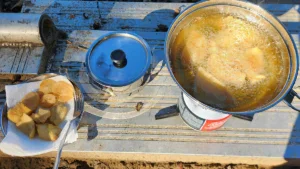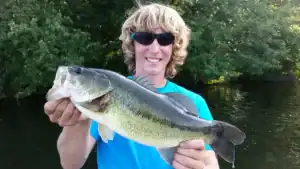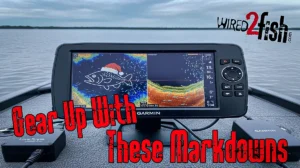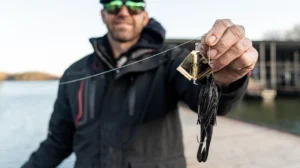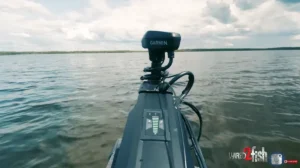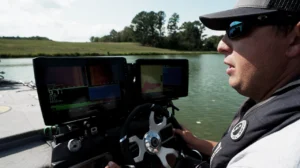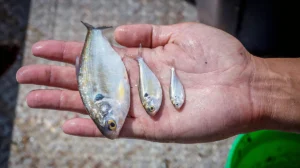Bank fishing for bass is incredibly fun and it also gives anglers of all skill levels a legitimate chance to catch the bass of a lifetime. Whether you’re a bank angler by choice or circumstance, you don’t need a boat or a huge selection of tackle to find bass, a little knowledge and the will to experiment is all that’s necessary.
Although I own a bass boat, I spend a considerable amount of time bank fishing. After a lot of tinkering and continuous experimentation, I’ve developed a very simple system that will help you locate and catch bass quickly. It’s not full of technical terms or complicated theories, just basic tactics that have allowed me to have a bunch of fun with friends and family.
Versatility means mobility
If you’re not adequately prepared to bank fish, you’re putting yourself at an immediate disadvantage. It’s important to understand, however, that I’m not suggesting buying the entire fishing aisle of your local tackle shop. That’s not necessary. Instead, just focus on a few essential things.
Most of us are guilty of over-packing for an afternoon fishing trip, but mobility is key when you’re bank fishing. Because you’re walking the shoreline, packing light will allow you to move and adapt quickly to changing conditions. I’ll usually bring about three rods that can be used for a number of different techniques.
- 7-foot, medium-action spinning rod, I can use this for any weightless soft plastic presentation. Whether I’m skipping a soft jerkbait under bushes, casting a floating worm to shallow stumps or twitching a wacky rig on subtle break lines, this rod will take of it. I actually like to use 8 or 10-pound test monofilament with this setup. Fluorocarbon sinks and makes it difficult to keep your soft plastic high in the water column.
- 7-foot, medium-heavy casting rod, In my opinion, this is one of the most versatile rods a bank angler can own. You can use it to fish Texas rigs, jigs, buzzbaits, spinnerbaits, topwaters and even fish small, shallow-running crankbaits around the shore. Using a 6.4:1 gear ratio casting reel will cover your bases for all of these techniques.
- 7-foot, heavy-action casting rod, It’s no secret that frog and toad fishing is an incredible bank fishing tactic, especially in small ponds. Many anglers use gear that’s too light for these tactics which results in lost fish and broken rods. This heavy-action rod may seem like a broom stick, but it’s necessary to get big bass out of heavy cover. Pair this rod with a 7.1:1 gear ratio reel and spool it up with some hardcore 65-pound braid. This is some of the most fun you can possibly have.
Mornings and evenings are very productive
I’ve caught some big bass from the bank in the middle of the day, but both my quantity and quality increases in lowlight periods such as mornings and evenings. We’re all busy folks, so it makes sense to optimize our chances when we can finally get away and fish for a few hours.
In bright, sunny conditions, bass tend to position very tightly to cover such as wood, grass and even rocks. Because we have a limited area to fish from the bank, sometimes this cover is out of casting distance, making it difficult to effectively target these already lethargic midday bass.
Bass “roam” a lot more in lowlight conditions, which can put more bass within casting distance. They’ll often feed in shallow water close to the shoreline, making them very accessible.
Choose high-percentage areas
It can be fun and sometimes productive trudging through the woods to find that secret bank fishing honey hole, but this tactic will severely limit your opportunities. We can’t fire up our boat engines and move to a new spot, so it’s important to choose areas that allow you to move efficiently and cover water quickly.
I think of it like this: If I pick a small spot from which to bank fish, there will likely be a small population of bass in that area. I can only cast so far, so my chances of getting those fish to bite are relatively small. When I choose a large stretch of bank that’s easy to traverse, however, I’m giving myself access to a much larger population of fish. If I don’t get a bite within a few casts, I can simply move down the bank a few feet and fish some new water. The ability to cover water quickly will drastically increase your success.
Subtle break lines produce big bass
It happens more often than we’d like to admit, you’re in an area with sexy blowdowns and good-looking cover everywhere and you cannot buy a bite. You try every tactic you can possibly think of without any luck whatsoever. So what’s up? Why aren’t the bass there?
The more obvious the cover is, the more fishing pressure it gets. The more fishing pressure a specific spot receives, the more wary and educated the bass will be.
To catch big bass that other folks are leaving behind, target subtle break lines, or areas in which the water depth changes. These break lines often create an edge on which bass love to position. Most banks will have a few feet of shallow water with a gradual taper into deeper water and bass use these depth changes for several reasons.
- Feeding, When the bass are inactive, they can simply hang out in the deeper water. When they decide to feed, however, these break lines give them very easy access to shallow forage such as bream and crawfish. A bass’ feeding mission is relatively simple, consume the most calories they can while using as little energy as possible. These break lines give them this opportunity.
- Travel, This doesn’t always apply to pond fishing, but in larger bodies of water bass use break lines as migratory routes. They often provide the path of least resistance, making it easy for bass to move to and from shallow areas throughout the year. Bass will use them just as we use highways, making them a high-percentage area regardless of the time of year.
- Ambush, Bass are opportunistic predators and depth changes provide them with outstanding ambush points. They’ll often lurk on these break lines and pin unsuspecting prey against the bank as they pass.
Understand the pecking order
I am by no means a biologist, but I believe that groups of bass follow a “pecking order” when feeding. When I’m fishing in areas with groups of bass, I frequently catch my biggest fish within the first few casts, followed by smaller fish on subsequent casts.
This is why it’s very important to make your first few casts count. Before hitting your best area, go ahead and get your backlashes and bad casts out of your system, one bad cast can derail your chances of catching a giant. Make a few practice casts on the bank first to make sure you’re ready to go. It sounds silly but in my experience it really works.
Don’t overpressure the juice
Whether I’m bank fishing or guiding trips from my boat, I refer to my best areas as “the juice”. And I do everything in my power to avoid fishing the juice too much. Bass become accustomed to seeing the same baits and lures on a regular basis and, in turn, won’t bite nearly as well. This has happened to my “juice pond” this year.
Last year, I could have guaranteed you’d catch a 6 to 8-pounder each trip to this pond, it really was that ridiculous. However, an increase in fishing pressure this year has totally jacked up the bass. They’re still there, but the darn things won’t bite. Now I can only catch small ones and the only solution is to let it rest.
You’re reading this article, so I know you love fishing. But take it from someone who’s dealing with the consequences this year, don’t fish your favorite bank fishing spots or ponds too much. Your results will suffer.
Instead, try to find other bank fishing opportunities. It can be hard because a few irresponsible anglers can ruin it for the good guys, but it’s important to have options. I won’t fish a pond more than one time every two or three weeks and it pays off big time. Here are some things I’ve done to gain permission to more private ponds.
- Work day, I’ve worked 10-hour days on the banks of ponds before ever making my first cast. Offer to cut the grass, trim the shoreline and maintain the entire pond area throughout the fishing season. Sure, it’s like having a second yard to cut, but it can be worth it to catch that double-digit bass hanging out in there.
- Pick up trash, I always pick up trash around my favorite ponds. Even if I didn’t leave it there, I always make sure to leave the area in better shape than I found it. Offer to clean the area thoroughly before leaving each time. Landowners appreciate the thought and gesture.
- Communicate, Always, always, always let the landowner know when you’re going fishing and when you’re leaving. I sure wouldn’t like to be randomly surprised by folks showing up in my yard. Be forthcoming and always communicate with them. Surprises won’t get you far.
- Share your success, Stop by their house one day and give ’em some already-cleaned bream or catfish you’ve caught from their pond. Stuff like that means a lot and heck, they get a free dinner out of the deal.
If you’re looking for an excellent way to catch big bass and get away from the crowds, bank fishing is a great choice. If you can keep your gear versatile, stay mobile, fish the overlooked areas and manage your fishing pressure effectively, you’ll have a heck of a time and learn a lot about bass behavior.




